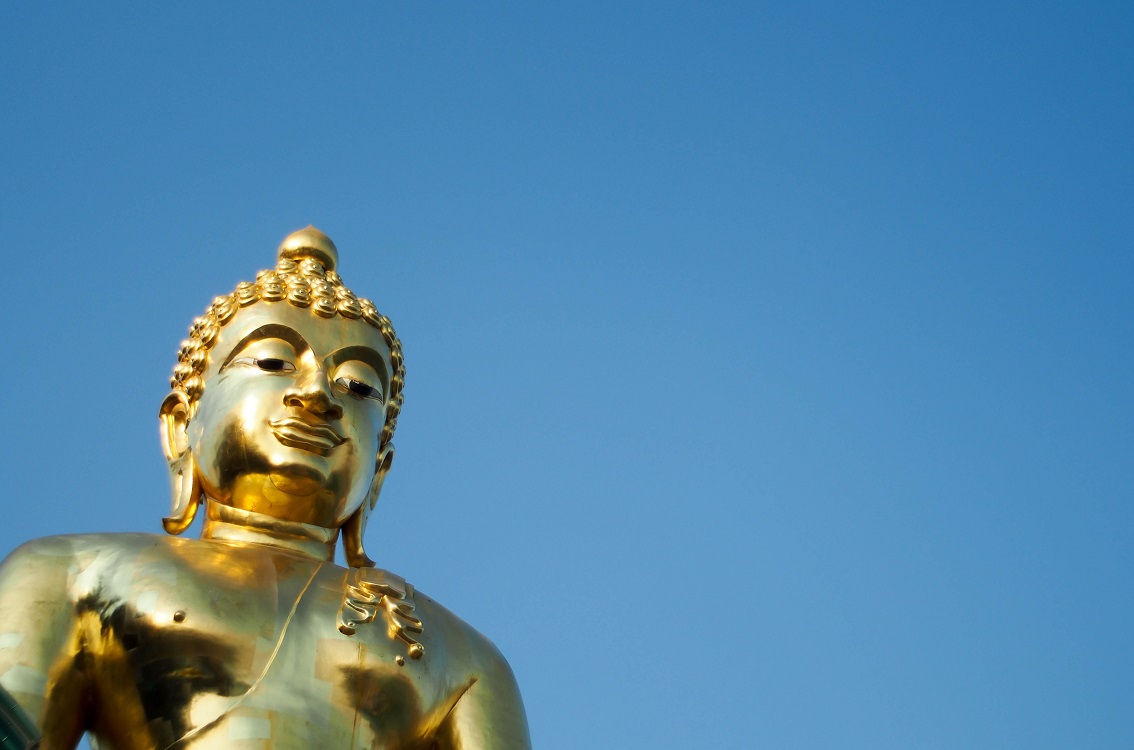Who is Buddha?

Buddha’s teaching is mostly based upon his insight. It starts with ‘duhkha’ (the act of clinging to impermanent things and states) and ends with ‘duhkha’ (the state referred to as Nirvana or Nirbbana). Nirvana means extinguishing three fires.
Gautama Buddha is popularly called Lord Buddha, Buddha Shakyamuni, Siddhartha Gautama, or Siddhattha Gotama or simply the Buddha. He was a Sramana born in ancient India during the 5th – 4th century BCE. He is considered to be the founder of Buddhism. Most Buddhist schools revere him as a savior of mankind. He is also known as the ‘Enlightened One’. He had rediscovered the ancient path to escape birth & rebirth cycle and to eliminate craving and clinging. Wherever he went, he spread knowledge for over 45 years. Through his wisdom, he managed to gain a large following. They comprised of the common people, monarchs and disciples.
His Teaching
Buddha’s teachings, also known as Dharma, emerged from his profound realization about the nature of suffering. This core concept, called “dukkha,” isn’t just physical pain, but a broader sense of dissatisfaction and unease that stems from clinging to impermanent things. We crave pleasure, possessions, and even fleeting states of happiness, but these are inherently impermanent. This clinging, according to the Buddha, leads to inevitable disappointment and suffering.
The path outlined in Buddha’s teachings ultimately leads back to the concept of dukkha, but in a transformative way. Nirvana, often translated as “blowing out,” signifies the extinguishing of the three fires of greed, hatred, and delusion. These are the root causes of our clinging and suffering. By following the Noble Eightfold Path, a framework for ethical living, mental discipline, and wisdom cultivation, we can gradually weaken these fires and achieve Nirvana. This state isn’t annihilation, but a profound liberation from suffering – a state of lasting peace and awakened understanding.
In essence, Buddha’s teachings offer a path from the initial recognition of suffering (dukkha) to its complete cessation, also referred to as Nirvana. This journey involves letting go of attachments and cultivating a more mindful and compassionate way of being.
His life
He was born in Shakya clan in an aristocratic family. Initially, his parents had kept him away from the hard facts of life. This is because at the time of his birth, it was predicted that he would become a mighty emperor or a renowned ascetic. He was married and gave birth to a child. But, at the age of 29, he had renounced his lay life to become an ascetic. He practiced asceticism, meditation and mendicancy for several years to know the truth of life. He realized the mechanism that traps people in the rebirth cycle. He travelled across the Genetic plain creating a religious community. He taught people the ‘Middle Path’ between severe asceticism that was prevalent during the Indian sramana movement and sensual indulgence. He also taught mind training abilities. It included self restraint, ethical training along with meditative practices like mindfulness and jhana. He desisted caste system and animal sacrifice.
Gautama was given the title ‘Buddha’ or the ‘Enlightened One’ or the ‘Awakened One after his death. The Vinaya Buddhist community had compiled his teachings and codes to perform monastic practice. They also compiled the ‘Suttas’ which are texts taken from his discourses. Through oral tradition, these sacred texts were passed onto the following generations in Middle Indo-Aryan dialects. Additional texts were later composed by the later generations in the form of systematic treatises like Abhidharma. Jataka Tales, Abhidarma were other compilations. Jataka tales is a collection of stories depicting Buddha’s past lives. Additional discourses were also compiled like the Mahayana Sutras.
Why is Buddha famous?
Buddha is famous for many reasons, but let’s keep it relaxed and simple.
Imagine a long time ago, in a place called India, there was a man named Siddhartha Gautama. He lived over 2,500 years ago. Now, Siddhartha was not just any ordinary person. He became known as the Buddha, which means “the awakened one” or “the enlightened one.”
So, why is Buddha famous?
Firstly, Buddha is famous because he taught something really important – about life, suffering, and how to find peace. He realized that life can be full of struggles and pains, like sickness, old age, and death. But he also believed that there was a way to overcome these sufferings.
Buddha’s teachings are like a roadmap for finding happiness and inner peace. He talked about things like being kind, compassionate, and understanding. He taught people to be mindful, which means paying attention to the present moment and accepting things as they are.
Secondly, Buddha’s story is pretty fascinating. He was born into a wealthy family, but he left all his riches behind in search of truth and meaning. He spent years meditating and reflecting on life. Eventually, he had a profound realization while sitting under a tree, which is now called the Bodhi tree. This moment of enlightenment transformed him into the Buddha.
People are drawn to Buddha’s story because it shows that anyone, no matter their background, can find wisdom and peace within themselves.
Thirdly, Buddha’s teachings spread far and wide. After his enlightenment, he spent the rest of his life traveling and sharing his wisdom with anyone who would listen. His message reached people from all walks of life – kings, farmers, merchants, and monks.
Buddha’s teachings eventually spread beyond India to other parts of Asia and eventually to the rest of the world. Today, millions of people around the globe follow his teachings and find guidance in his words.
Lastly, Buddha’s image is iconic. You’ve probably seen statues or paintings of him sitting cross-legged with a serene expression on his face. This image symbolizes peace, wisdom, and enlightenment.
So, to sum it up, Buddha is famous because he taught important lessons about life and suffering, his inspiring story resonates with people, his teachings have spread far and wide, and his image represents peace and wisdom. Buddha’s legacy continues to inspire and guide people to this day.
What are the 3 main beliefs of Buddhism?
Picture this: you’re sitting under a shady tree, sipping your favorite drink, and pondering the essence of life. That’s kind of what Buddhism is about – finding peace and understanding in the midst of life’s chaos.
So, what are the three main beliefs of Buddhism?
Firstly, there’s the concept of Dukkha, which basically means “suffering” or “unsatisfactoriness.” Now, before you start feeling down, it’s not all doom and gloom. Buddhism acknowledges that life can be tough sometimes – we experience pain, loss, and dissatisfaction. But here’s the thing: recognizing this suffering is the first step towards finding peace. Instead of ignoring or running away from it, Buddhism teaches us to face it head-on and understand its root causes.
Next up, we’ve got the idea of Anicca, which means “impermanence” or “change.” This belief is all about understanding that everything in life is constantly changing – our thoughts, feelings, relationships, even the seasons. Nothing stays the same forever. While this might sound a bit unsettling at first, it’s actually quite liberating. Embracing the impermanence of life helps us let go of attachments and live more freely. Instead of holding on tightly to things that are bound to change, we learn to go with the flow and appreciate each moment for what it is.
Lastly, there’s the concept of Anatta, which translates to “non-self” or “no soul.” This belief challenges the idea of a fixed, permanent self or soul. Instead, Buddhism teaches that our sense of self is more like a collection of ever-changing thoughts, feelings, and experiences. Understanding this can help us break free from the illusion of separateness and realize our interconnectedness with all living beings. It’s like realizing that we’re all just tiny drops in the vast ocean of existence – separate yet connected in a beautiful, cosmic dance.
So, there you have it – the three main beliefs of Buddhism: Dukkha (suffering), Anicca (impermanence), and Anatta (non-self). While these concepts may seem simple on the surface, they hold profound wisdom that can help us navigate the ups and downs of life with grace and understanding. So, next time you find yourself pondering the mysteries of existence, just remember these timeless teachings and take a deep breath. After all, in the end, it’s all about finding peace amidst the chaos.




